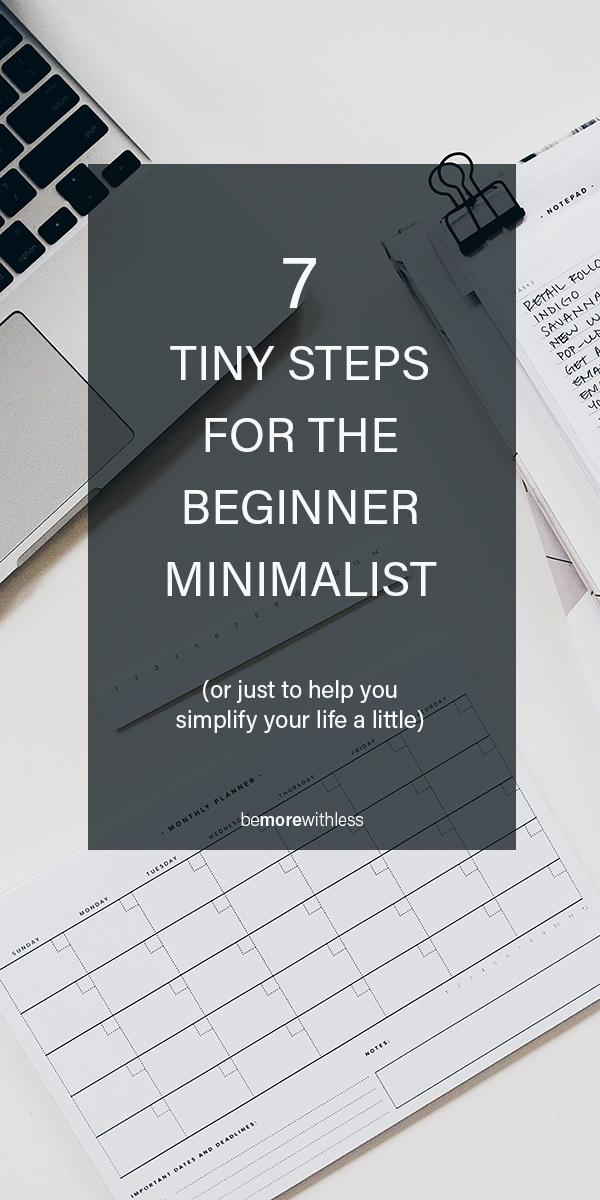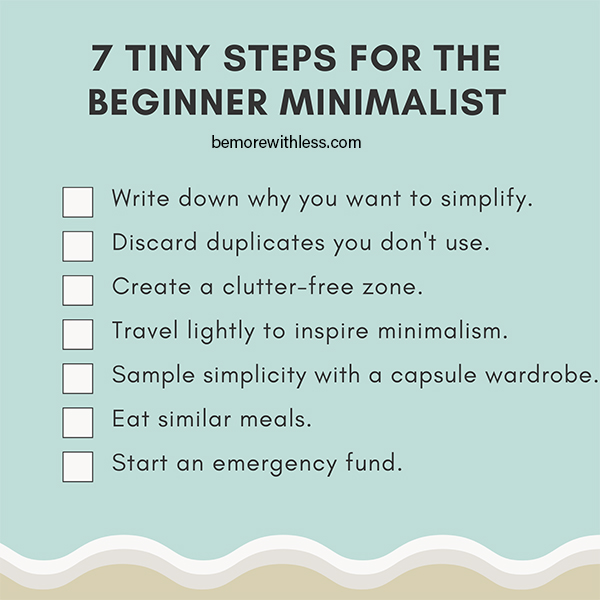7 Tiny Steps for the Beginner Minimalist
If you are a beginner minimalist or restarting a simplicity journey, these tiny steps will help you move forward with less stress and more ease. If you are considering or curious about minimalist living, you may be thinking one of the following …
1. Let’s go! Where’s the dumpster.
2. No thanks – I don’t have a stuff problem, I have a space problem.
3. I’m interested, but I don’t know where to start.
You may think all of these thoughts! As a beginner minimalist, you might be in search of a good decluttering process or simple living motivation. Less clutter and owning fewer possessions is definitely part of a minimalism journey but it’s usually only the start of a bigger life change. Other steps may be looking at what you purchase, what your daily habits and routines look like and noticing where excess appears in your life in negative way.
Even though I’ve made big changes in my life, it’s been a slow, step-by-step adventure in developing a minimalist mindset.

My minimalist journey and how I live a more intentional life
While I never had a specific destination in mind, I knew I wanted to reduce stress and create more room to feel good and be present in my life. I simplified my diet, stuff, debt, health, home and schedule. It took years, hundreds of tiny steps, and I’m still making progress. There are a few reasons why I intentionally take my time.
- In my experience, slow shifts are more sustainable than radical change.
- I have a family and didn’t want to create a stressful life in search of a simple life.
- I want time to experiment and discover what enough really means at each stage of my life.
- Getting rid of stuff and owning fewer things was never the goal. I want to know what matters to me and why I’m making space. That takes time.
- I am still experimenting and defining enough. I don’t have an end point in mind.
If you are a minimalist beginner or somewhere in your journey to simplify your life, consider these tiny steps. These minimalist tips will help in different areas of your life.

1. Write down why you want to simplify your life.
Make a list of all the reasons you want to live more simply. If you are sick of debt collectors, write it down. Mad that you never get any time with your kids? Write it down. Tired of being tired because anxiety and stress keep you up at night? Put it on paper. Want to fire your boss? Yep, write that down too. These are your whys and your whys will provide great leverage when you think it’s too hard to keep going. Your whys will give you clarity and help you remember what matters as you make progress.
Minimalist lifestyle tip: Don’t worry about proving why you want to simplify to the people around you who may not understand. There will be time for conversations later. For now, lead by example.
2. Discard the duplicates you never use.
Walk through your home with a box and fill it with duplicates. If you have two sets of measuring cups, put them in the box. Copies of the same book or DVD? Put one in the box. Doubles on linens? Consider how many you really need. Once you fill the box, label it “Duplicates” and put it out of sight for 30 days. If you don’t need anything or don’t remember what was in the box, donate it.
Sweep your counters and drawers for obvious extras. You may find duplicates in your junk drawer too. There will be some areas of your life where you want to keep more than one of an item. For instance, I tried to only own one pen and that was an experiment that clearly demonstrated, I need more than one pen. Do what is best for you.
3. Create a clutter-free zone.
This area could be a kitchen table, your nightstand, a corner in your living room or a drawer in your kitchen. Use that clutter-free zone as inspiration to live with less. If you enjoy that clean, clear environment, expand the zone a little bit each day. A clutter-free countertop can become a clutter-free room and a clutter free room can become the clutter-free, minimalist home you’ve been thinking about. Let the minimalist sanctuary you create be a reminder of what you want to create in other areas of your home and life.
If you live with other people, don’t worry about their stuff and personal spaces but do ask them to honor the clutter-free zone you create.
4. Travel lightly to inspire minimalism.
Travel always renews my love of minimalism and living simply. The next time you take a trip, pack for half the time you are traveling. If you are traveling for 4 days, pack for 2. You can wash and hang clothes if you need to or wear the same things twice. See how it feels to carry less baggage and notice what it feels like to be away from your day-to-day possessions. What could you live without? What don’t you miss at all?
5. Sample simplicity with a capsule wardrobe experiment.
Start in your closet and create a capsule wardrobe. Use minimalist fashion challenge Project 333, and dress with 33 items for 3 months (clothes, shoes, jewelry, accessories). This is one of those experiments I mentioned earlier. The benefit of a challenge or experiment is that you can sample simplicity without a bigger commitment of getting rid of all of your stuff. If a capsule wardrobe isn’t for you yet, consider a closet clean out.

6. Eat similar meals for less decision fatigue.
This might sound silly but if you get overwhelmed by wondering, “What’s for dinner?” or struggle to meal plan (I did), consider eating similar meals. When you think about how much time you spend thinking about what you are going to eat for lunch, make your family for dinner, or what you need to pick up at the grocery store, it’s clear that food is not always simple. Try eating the same breakfast and lunch all week and have two or three dinner choices that rotate throughout the week.
Keep a list of the meals that work best for you and your family and make a list each week of what’s on the menu. You can rotate in a new meal each week and change things up seasonally. Keeping this process really simple has helped me to stay consistent, eat healthier and save money on last minute meal delivery or grocery shopping when I’m stressed and hungry.
7. Start a small emergency fund.
An emergency fund simplifies everything. If you are paying off debt, only pay your minimum payments until you can save about $1000. If you aren’t in debt and still need to gradually build your emergency fund, try to spend less and set aside money every day or every week until you reach $1000. Try the 52 week money challenge and in 45 weeks, you’ll save more than $1000 without ever contributing more than $45 in a week. Money for emergencies reduces stress.
If these 7 tiny steps for the beginner minimalist don’t feel tiny to you, make them smaller. Don’t worry about long any step takes. Honor your own time and energy availability. Even if it takes 10 years to get to where you think you want to be, the benefits begin immediately.
The beauty of being a beginner minimalist is that you can be curious, and daring. You can ask for help, get back up if you fall, and look forward to new adventures in a life with less stress, stuff, drama, debt, and obligation.
P.S. A few times a year, we open The Simplicity Space (the simplify your life support system). Learn more here.
The post 7 Tiny Steps for the Beginner Minimalist appeared first on Be More with Less.
